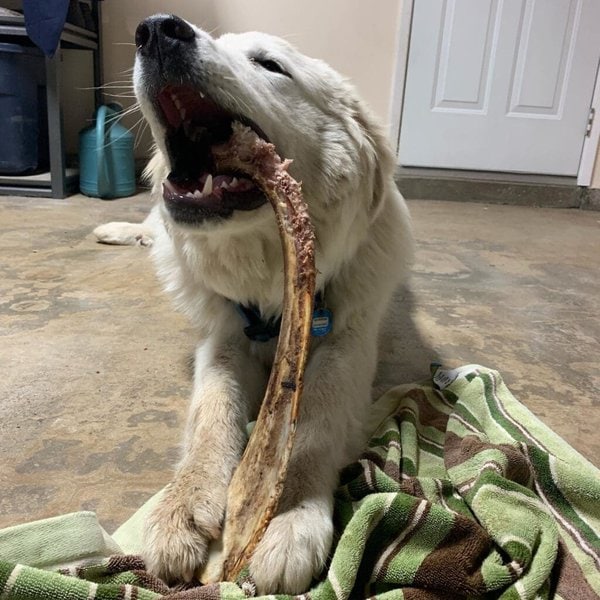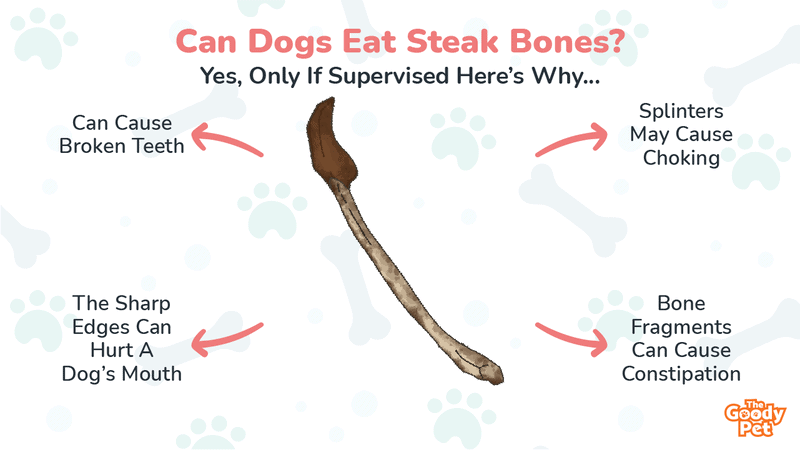Give a dog a steak bone, and its tail wags non-stop, right? Images of dogs chewing on a bone are a common sight that we think go hand in hand. Besides, throwing in that good piece of steak bone for a satisfying treat is all we want for our furry baby. But is it safe?
Chewing on a bone actually may have some health and safety hazards for your furry baby, especially that leftover bone from a steak you just enjoyed. This could cause problems like choking and broken teeth.
Many veterinarians consider it a myth that dogs need to chew on bones, and we all know how much Fido loves that bone. But before giving your dog a steak bone, read on to find the dangers lurking behind this common practice.
We will also discuss the number of things that might occur when dogs chew on a bone and the things you can do to prevent such accidents from happening.
Can Steak Bones Hurt Dogs?
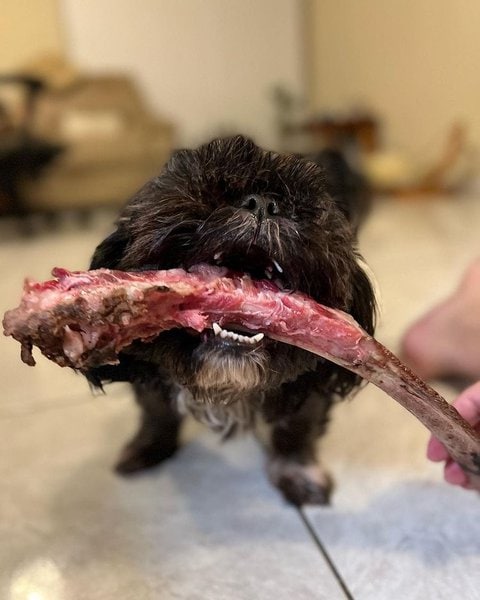
It depends on the cut of the steak bone and whether or not it is cooked or raw.
Chewing on just about anything is instinctively hardwired on our dog’s brain, which they do for mental stimulation, for relieving anxiety, and just for fun.
But, chewing on a steak bone may pose some dangers to your dog’s health, such as the following:
Choking
Steak bones may splinter during the chewing process and may get lodged in your dog’s throat or injure the soft tissue of the esophagus.
Choking is more common in cooked bones since the heat has somewhat softened the bone tissue and can crack easily.
There is also the possibility of a bone fragment blocking their windpipe, hampering their ability to breathe.
Broken Teeth
Our dogs can sometimes get overly enthusiastic or excited when given a bone treat by biting too hard on it. This could lead to a cracked tooth or, in some situations, a loosened tooth.
There are some cases of a bone getting stuck in the lower jaw or loop behind the lower teeth, thereby requiring sedation and surgery.
Mouth Lacerations
Dogs can easily injure their tongues, cheeks, or soft palate with the sharp edges of a broken bone.
Peritonitis
Razor-sharp fragments of bone can also injure the stomach and the inner linings of the intestines.
This could lead to digesting food leaking into the abdomen and causing inflammation in the abdomen called peritonitis.
Stomach And Intestinal Blockage
Large bone fragments can get trapped in the stomach or the intestines. If it is unable to pass through, this can lead to vomiting and stomach irritation that may require surgical removal.
Constipation
Bone fragments can also collect in your dog’s large intestine, causing constipation. Small pieces can get dissolved and pass through the intestines easily, but larger fragments may not break down quickly.
The tiny shards of bone can also scrape the linings of the colon and rectum, making it harder to pass waste. An enema may be needed to ease bowel movement.
Bacterial Contamination
Some meat and bones may be contaminated with Escherichia coli (E. coli), Listeria, or Salmonella without you knowing it.
It depends on your dog’s health whether it can pose a health risk to them, but the bacteria may spread around the household making children or the elderly at risk of infection.
The Other Signs That Your Dog May Have Been Injured From Eating A Steak Bone
You may not notice these signs immediately after the ingestion, and some of them may wear off after the bone passes. But, if you’ve observed any of the, make an appointment with the veterinarian asap:
Can Dogs Eat Cooked Steak Bone?
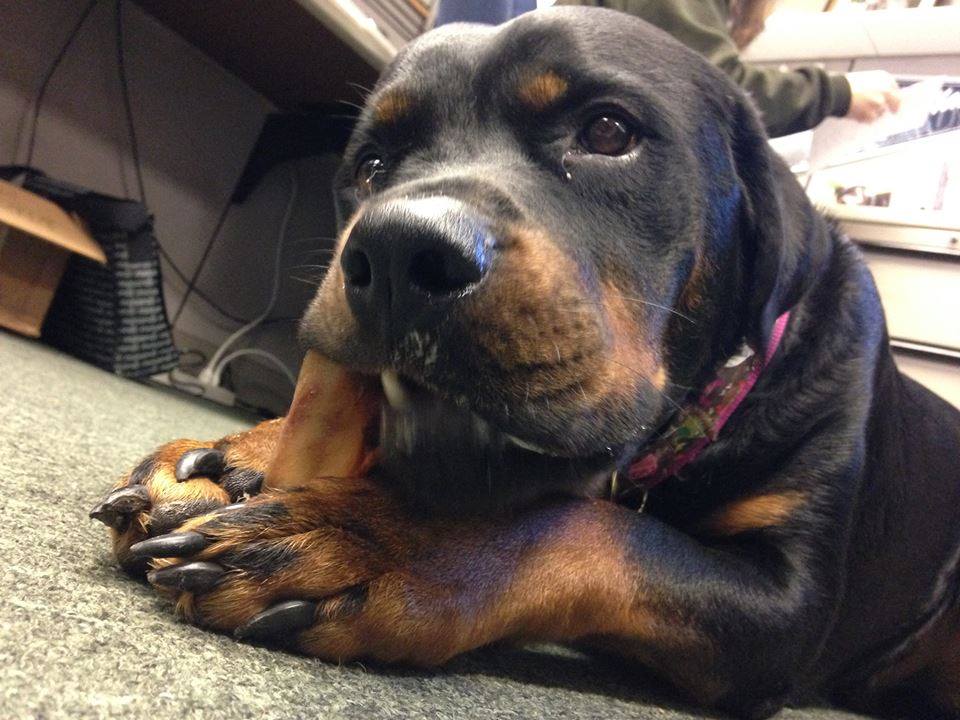
No, when it comes to bones, many would recommend giving raw steak bones to overcooked ones. Whether boiled, baked, or smoked, cooked steak bones can easily crack because of the softened bone tissue.
Most of the injuries discussed above are due to cooked steak bones or other animal bones that dog owners give to their dogs.
Aside from easily getting splintered, cooked bones have less nutritional benefits for our dogs since the cooking process has stripped them of many nutrients.
Are Raw Steak Bones OK For Dogs?
Yes, and there are mainly three benefits of giving a raw steak bone to your dog. For oral health, for additional nutrients, and to satisfy their chewing instinct.
When it comes to raw steak bones, it is advised that you give your dog bones that are bigger than their heads. Smaller and thinner pieces of bone, like rib bones, can easily get swallowed and choke our pets.
It is also recommended that you source the bones from reliable butchers to lessen the probability of pathogen contamination.
For Oral Health
First, it is an effective way of getting rid of plaque in their teeth and gums. Raw steak bones have naturally occurring enzymes that break down the thick film of plaque that regular brushing and toothpaste cannot easily permeate.
Chewing on a raw bone can gently scrape off the plaque, thus minimizing the possibility of periodontal diseases.
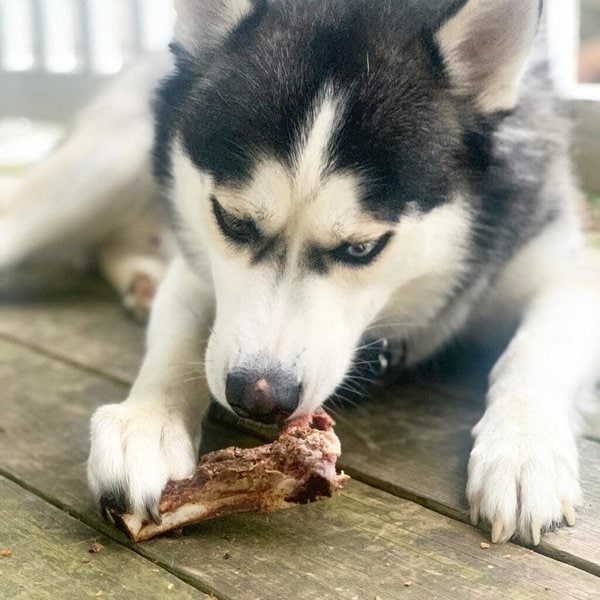
For Nutrition
Second, raw bones and the marrow inside have small amounts of protein, fat, calcium, and phosphorus.
Since these are only meant to be chewed, raw bones are great as occasional treats.
For Primal Instinct
Lastly, a raw bone can satisfy your dog’s instinct to chew. It is an engaging activity that has the added benefit of developing their skull, jaw, neck, and shoulder muscles.
How Can I Give A Steak Bone Safely To My Dog?
By sticking to some guidelines, you may occasionally give a steak bone to your dogs and not worry about the possible injuries.
Supervise
Always be present when you have just handed a piece of steak bone to your dog. If your dog starts to gag or if you notice that the bone has splintered or reached a size that is small enough to get swallowed whole, retrieve the bone carefully.
Also, never let your dog bury the bone to prevent any bacterial infections should it be dug up later and chewed on. Throw the bones one or two hours after giving it.
Pick The Right Bone
Make sure to give it raw instead of cooked steak bones.
The size should be just right for your fur baby. Anything smaller than the head can be a danger. Thaw the frozen bones before giving since frozen bones are more brittle.
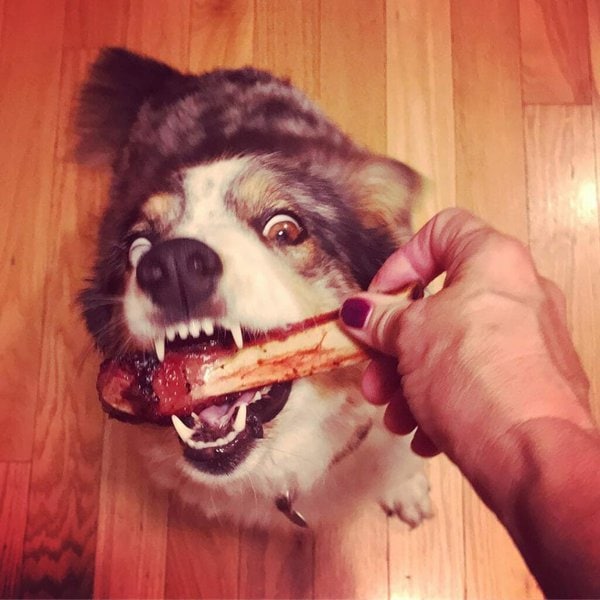
Choose The Right Time
Never give a steak bone to a hungry dog. Dogs are likely to be more enthusiastic about chewing hard on the bone when they are starving and may injure their mouths or swallow a big chunk of bone in the process.
Limit It
Give steak bones only as an occasional treat. Too much raw bone can cause constipation in dogs.
Be Aware Of Your Dog’s Current Health
If your dog has some dental problems or is prone to digestive problems, avoid giving bones in general. Check with your veterinarian to know the right supplemental treats that are perfect for your dog.
What Can I Give My Dog In Place Of Steak Bones?
Since today’s dog foods are complete with enough nutrients to cover their daily requirements, they do not need bones as part of their diet, unlike their wild ancestors.
But, to satisfy their chewing urge, there are several products in the market you can choose from.
For rawhides, opt for something they could not easily swallow, preferably with no knots at the tips since these can easily be pulled off and swallowed.
There are also non-edible chew toys that have tough and durable covering with various flavors to choose from.
Finally, there are dental chews that have the added benefit of supporting their dental health.
